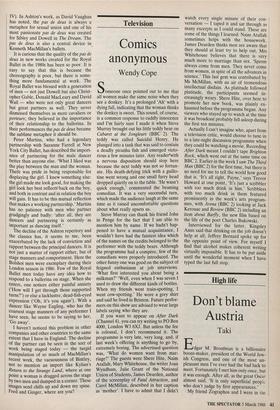Dance
Goodbye to romance
Last week Antoinette Sibley made her farewell appearance at Covent Garden. I missed all her great years but in the early 1980s she made a tentative comeback and gradually resumed more and more roles in the repertory, particularly in Ashton's ballets.
Sibley's dancing was a revelation: grand, lyrical, musical, with a wonderful ease and spaciousness in the way she phrased the steps. What was a shock to me, especially when I saw her in Cinderella in 1985, was that next to the other dancers she looked like someone from another planet. Critics have been moaning about the state of the Ashton repertory for years and there it was, right before my eyes. Where Sibley was grand and lyrical, the other dancers looked cramped and small-scale; where she was musical, they were mechanical. It was Ashton who constantly nagged at Sibley to return to dancing, perhaps in the hope that Sibley would provide inspiration to the younger generation of Royal ballerinas. After watching the lifeless revival of Sym- phonic Variations recently, a touchstone ballet not just for the Ashton repertory but for the company's history, I felt Sibley's influence was sorely needed. One can hardly discuss Sibley without reference to Anthony Dowell. Their part- nership dominated the Royal Ballet, at home and abroad, in the 1960s and 1970s. He partnered both Sibley and Jennifer Penney in their farewell performances in Manon last week and he, too, is nearing the end of his performing career. It is odd that since Sibley and Dowell the Royal Ballet has never seriously cultivated another partnership. It is true that in the 1960s there was a frantic overselling of Fonteyn and Nureyev, particularly during the Royal Ballet's American seasons, which created a serious log jam for the dancers behind them. Nevertheless, watch- ing Dowell with Penney and Sibley last week I realised the huge gap he will leave when he retires from dancing. The pas de deux is a metaphor for many aspects of the relationship between men and women. In the classics it is often both a celebration and a consummation (The Sleeping Beauty, Raymonde), or expiation and forgiveness (Giselle, Swan Lake Act IV). In Ashton's work, as David Vaughan has noted, the pas de deux is always a metaphor for sexual union and one of his most passionate pas de deux was created for Sibley and Dowell in The Dream. The pas de deux is also a central device in • Kenneth MacMillan's ballets.
It is curious that the quality of the pas de deux in new works created for the Royal Ballet in the 1980s has been so poor. It is easy to say that this is because the choreography is poor, but there is some- thing more fundamental at work. The Royal Ballet was blessed with a generation of men — not just Dowell but also Christ- opher Gable, Donald MacLeary and David Wall — who were not only great dancers but great partners as well. They never dismissed themselves as mere cavaliers or porteurs; they believed in the importance of their relationship to the ballerina. In their performances the pas de deux became the sublime metaphor it should be. Peter Martins, who had a legendary partnership with Suzanne Farrell at New York City Ballet, has described the import- ance of partnering for the male dancer better than anyone else. 'What I liked was the play between the man and the woman. Thete was pride in being responsible for displaying the girl. I knew something else: the girl made me look good, for making the girl look her best reflects' back on the boy, and both in contrast and in relation the boy will gain. It has to be this mutual reflection that makes a working partnership.' Martins has no patience with men who partner grudgingly and badly: 'after all, they are dancers and partnering is certainly as important as dancing itself.' The decline of the Ashton repertory and the classics has, it seems to me, been exacerbated by the lack of conviction and rapport between the principal dancers. It is not just a matter of rapport either, but of stage manners and comportment. Here the Bolshoi men were exemplary during their London season in 1986. Few of the Royal Ballet men today have any idea how to respond to a ballerina on stage. When she enters, one notices either painful anxiety (`How will I get through those supported turns?') or else a lacklustre, dead-fish-eyed expression (`Oh, it's you again'). With a dancer like Wayne Eagling, who has the coarsest stage manners of any performer I have seen, he seems to be saying to her, `Go away'. I haven't noticed this problem in other companies and other countries to the same extent that I have in England. The decline of the partner can be seen in the sort of work being staged today — the turgid manipulation of so much of MacMillan's recent work, the vacuousness of Bintley, not to mention an import like Kylian's Return to the Strange Land, where at one point a woman is dragged across the stage by two men and dumped in a corner. These images send chills up and down my spine. Fred and Ginger, where are you?



















































 Previous page
Previous page